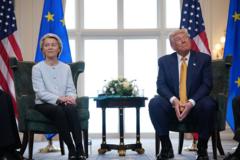Is the EU-US Tariff Deal Stalled by Trump's Unpopular Terms?

The EU-US Trade Agreement: An Overview of Implications and Future Steps
In a significant development for international trade, European Commission chief Ursula von der Leyen and US President Donald Trump declared a new EU-US trade agreement after extensive negotiations. This announcement came ahead of Trump's self-imposed deadline of August 1, leading to a collective sigh of relief in Europe as it averted the looming threat of 30% tariffs that had been proposed earlier. However, while the agreement has been welcomed as a step towards stability, it has also sparked criticism and raised questions about its implications, particularly concerning the impact on various EU nations and industries.
The Terms of the Agreement
The trade agreement outlines a 15% tariff on most EU exports to the US, which marks a notable increase from the previous average tariff rate of 4.8%. While this is an improvement over the initially threatened 30% tariff, it has left many European leaders feeling unsatisfied. Germany's finance minister Lars Klingbeil expressed disappointment, stating, "I would have wished for a different outcome," while recognizing the necessity of having an agreement to avoid further escalation. The primary aim of this deal appears to be to provide a measure of predictability and stability for Europe's businesses after a tumultuous period of negotiations.
Political Commitments Versus Binding Agreements
As negotiations progressed, one of the critical points of contention has been the nature of the commitments made by each side. While the EU's outline of the agreement emphasizes that it is not legally binding and refers to a "set of political commitments," the US has framed the deal as achieving "historic structural reforms." This discrepancy has raised concerns about the reliability of the commitments made, particularly as ongoing discussions reveal that many details remain unresolved.
Key Discrepancies in Agreement Details
Several major discrepancies exist between the EU and US interpretations of the agreement. For instance, the US claims that the EU will purchase $750 billion in American energy products, while the EU merely states it "intends" to do so. This presents a significant concern, as it raises questions about whether the US can supply such quantities and whether the EU can dictate private sector purchasing decisions. Additionally, discussions around the EU's investment commitments have been contentious, with the US asserting that the EU "will" invest $600 billion by the end of Trump's second term, in contrast to the EU's statement that companies have merely expressed interest in such investments.
Impact on Specific Industries
The 15% tariff will not be evenly distributed across EU countries and industries. Germany, Ireland, and Italy stand out as particularly vulnerable. For instance, German automotive exports to the US represent 13% of total exports, amounting to €34 billion. Hildegard Müller, the president of the German Association of the Automotive Industry, voiced concerns that the new tariffs would impose a substantial cost on the sector. Meanwhile, Ireland's economy relies heavily on the US market, particularly in pharmaceuticals, which account for approximately $50 billion in exports annually. State Minister Neale Richmond summarized the sentiment by stating, "It is what it is and we move on."
Potential Economic Ramifications
The economic implications of the new tariffs could be significant. According to the Italian Institute of International Political Studies, Italy's GDP could experience a 0.2% decline due to the 15% levy. The agricultural, pharmaceutical, and automotive sectors in Italy are expected to be particularly hard-hit. Cristiano Fini from the Italian Confederation of Farmers described the agreement as feeling more like "a surrender" than a mutually beneficial arrangement, highlighting the growing discontent among Italian trade associations who are already seeking compensation from the EU for anticipated losses.
The Need for a Firm Approach
As negotiations continue, there is a pressing need for European leaders to adopt a firmer stance in dealing with the US. French President Emmanuel Macron emphasized that "in order to be free, you have to be feared," indicating that Europe needs to assert itself more strongly in future negotiations. The response to the backlash received by the European Commission suggests that negotiators may face increased pressure to defend their interests and advocate for a more equitable trade landscape.
Conclusion: An Ongoing Negotiation Process
While the EU-US trade agreement brings a degree of certainty, it also opens the door to a lengthy negotiation process aimed at refining various aspects of the deal. The current 15% tariff will likely be a temporary measure as both sides work to address the discrepancies and concerns that have emerged since the announcement. The stakes are high for European economies, and the outcomes of these negotiations will undoubtedly shape the future of transatlantic trade relations.
FAQs
What are the main features of the new EU-US trade agreement?
The key features include a 15% tariff on most EU exports to the US, with numerous details still under negotiation. The agreement aims to provide a degree of predictability for businesses while addressing specific sectors differently.
How will the tariffs affect the EU economy?
The tariffs are expected to have varying impacts across EU countries, with Germany, Ireland, and Italy being particularly vulnerable due to their reliance on exports to the US. Economic analysts predict a possible decline in GDP for these nations.
What are the key discrepancies between the EU and US interpretations of the agreement?
Discrepancies include language used regarding purchase commitments, with the US stating that the EU "will" buy certain amounts of US products, while the EU merely states "intends" to do so. This raises questions about the feasibility and enforceability of these commitments.
What is the future of EU-US trade relations?
The future of EU-US trade relations will depend heavily on the outcomes of ongoing negotiations. As both sides work to address existing gaps and discrepancies, the way forward will shape the landscape of international trade for years to come.
As the EU and US navigate this complex trade agreement, one must consider how these developments will impact global trade dynamics. Will Europe manage to secure a more favorable position in the negotiations ahead? #TradeAgreement #EUEconomy #USTrade
Published: 2025-07-31 16:35:17 | Category: wales



